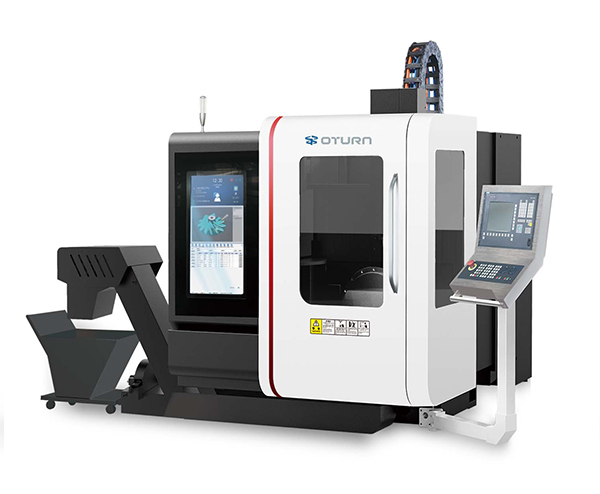In the landscape of modern manufacturing, five-axis high-speed CNC machining center have become indispensable tools for producing complex parts. They represent not only high efficiency and precision but also a revolutionary production model that significantly improves product quality and market competitiveness. A deep understanding and effective implementation of machining strategies are key to unlocking their full potential.
Core Advantages: Integrated Machining and Minimizing Errors
The most notable advantage of 5-axis CNC machining centers lies in the coordinated movement of five axes, enabling “multi-face machining in a single setup.” This “one-stop” machining approach fundamentally overturns the traditional multi-process, multi-setup methods, bringing multiple benefits.
Firstly, it drastically reduces the number of setups and workpiece repositioning time. Each setup and repositioning adds auxiliary time and potential positioning errors. The integrated nature of five-axis machining eliminates these issues, significantly shortening the overall machining cycle. For example, a part requiring three setups on a traditional three-axis machine can usually be completed in one setup on a five-axis center, improving production efficiency by at least 20%.
Secondly, by avoiding repeated setups and calibrations, cumulative errors caused by multiple adjustments are greatly reduced, ensuring higher machining accuracy and part consistency. This is critical for industries such as aerospace and medical devices, where precision is paramount, and it substantially lowers scrap rates caused by secondary positioning.
Optimizing Toolpaths and Cutting Parameters: The Foundation for Speed and Efficiency
Maximizing the efficiency of 5-axis CNC machining center hinges on optimizing toolpaths and cutting parameters. This requires precise simulation and optimization using advanced CAD/CAM software. By predefining and adjusting toolpaths, unnecessary machine movements and air cutting can be minimized—for instance, avoiding tool travel outside the machining area or choosing the shortest path when switching machining faces. This is akin to planning the most efficient highway for the machine to complete its task in the shortest time.
Moreover, selecting appropriate cutting tools and setting reasonable cutting parameters are crucial to ensure quality and efficiency. High-quality tools, especially those designed for high-speed cutting, can withstand higher cutting speeds and feed rates while maintaining stable cutting performance. Precisely controlling cutting depth and width to avoid “over-cutting” not only extends tool life and reduces tool consumption costs but also prevents vibration and deformation caused by excessive cutting forces, ensuring machining accuracy and surface finish. For example, in machining certain materials, a strategy of high feed and shallow cut depth often yields higher material removal rates and lower tool wear compared to low feed and deep cuts.
Enhancing CNC Programming Skills: The Driving Force of Smart Manufacturing
The CNC programming level directly impacts the efficiency and quality of five-axis machining. Skilled programmers can design optimal machining strategies and toolpaths based on part geometry, material properties, and machining requirements, thereby fully leveraging machine capabilities. Enterprises should continuously invest in training to improve programmers’ proficiency with various software (such as NX CAM, Mastercam, and hyperMILL) and advanced techniques including complex surface machining, multi-axis interpolation, and collision detection.
Additionally, optimizing programming workflows to reduce errors and revisions is an effective way to improve efficiency. This can be achieved through standardized programming protocols, knowledge reuse via libraries, and simulation software to verify machining processes before actual cutting. Comprehensive pre-machining simulation helps avoid common issues like collisions and overcuts, reducing costly trial cuts and potential equipment damage.
Cost Optimization: Lean Manufacturing and Intelligent Management
Beyond efficiency and precision, cost optimization remains a key concern for enterprises. This requires multifaceted approaches. Implementing lean manufacturing principles is essential. By identifying and eliminating various wastes—such as overproduction, waiting, transportation, over-processing, inventory, unnecessary motions, and defects—production costs can be significantly reduced while resource utilization improves.
Furthermore, optimizing material and energy consumption is critical. For example, optimizing nesting and toolpaths minimizes raw material waste. Introducing intelligent monitoring systems to track CNC machine energy consumption in real-time and dynamically adjust parameters based on load and operating conditions can effectively prevent unnecessary energy use.
Talent Development and Technological Innovation: The Driving Forces for Sustainable Growth
Ultimately, talent cultivation and technological innovation are the inexhaustible engines driving dual optimization of efficiency and cost in five-axis machining centers. Enterprises should focus on training operators and maintenance staff to proficiently handle daily operations, troubleshooting, and routine maintenance, ensuring stable machine performance and maximum utilization.
Simultaneously, companies must maintain a keen focus on innovation. This includes actively exploring and adopting new cutting tool materials (such as PCD and CBN), new processes (like dry cutting, minimum quantity lubrication (MQL), laser-assisted machining), and automation solutions (such as robotic loading/unloading and automated inspection systems). These cutting-edge technologies not only further boost machining efficiency and reduce unit costs but also help enterprises maintain a competitive edge and achieve sustainable development.
Conclusion
The potential of 5-axis high-speed CNC machining center lies in the comprehensive application of multi-dimensional strategies, including machining optimization, programming enhancement, maintenance strengthening, and lean management. Coupled with ongoing talent development and technological innovation, enterprises can fully unleash the value of five-axis machining centers to achieve efficient, precise, and cost-effective smart manufacturing, securing a leading position in the fiercely competitive market.
As your professional partner, OTURN is committed to providing one-stop metal machining solutions to support the continuous growth and breakthrough of your manufacturing business.
Post time: Jun-27-2025








